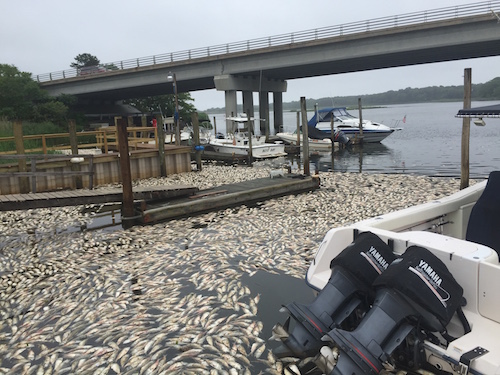As the Peconic River teems with thousands of dead fish after another bunker kill, town and county officials are struggling to find solutions to deal with the clean-up – and the stench.
“It’s totally disgusting,” said Joanne Tyte, who lives on Howell Lane on the Peconic River. “The smell is so bad that we can’t even go outside.”
Last month’s major fish kill washed up tens of thousands of dead bunker on shores from the Peconic River to the Peconic Bay after algal blooms starved the water – and its bunker fish – of oxygen. And last weekend, oxygen levels in the Peconic River once again dropped very low due to another algal bloom, triggering yet another fish kill.
Fortunately, this weekend’s kill appears to be smaller than last month’s, but it has washed up thousands more stinky dead fish near the homes of fish-weary residents who are still reeling from the remains of the last kill.
“Since June 7, we’ve had nothing but southerly winds, and that’s just been carrying that smell to our house,” said Jennifer Parillo, who lives on Riverside Drive. “It just hasn’t stopped. It keeps on coming.
“I don’t think you can count on the wind blowing to clean up this mess,” she added.
But for the moment, local officials are having a difficult time finding a better solution.
The sheer volume of dead fish that has washed up in marshland, which is inaccessible to nets, as well as on private property, where the town cannot trespass to remove the fish, has made cleanup “extremely difficult,” Town Supervisor Sean Walter says.
“There’s just not enough manpower in Riverhead to take care of this,” Walter said. “We’re doing everything we can to keep the public areas as clean as possible, but a lot of this is private property. Even if we had the manpower, we couldn’t go onto those properties.”
He pointed out the difficulty of cleaning out a private marina where dead fish tend to build up and sit in the stagnant water, such as the marina at the Moose Lodge. “We would need to take every single boat out of there to get those fish,” he said. “I don’t think that’s even possible.”
Marshy areas where the fish get caught in reeds and grasses pose another challenge. “There’s no way to remove those fish except by hand,” said Suffolk County Legislator Al Krupski.
Many of those marshy areas are also “environmentally sensitive,” Walter said. “You’d be doing more harm disturbing those areas than the good you’d be getting out of removing the fish,” he said.
And then there’s the question of what to do with the fish once they’re out of the water. Residents who bag dead fish from their private properties can call the town for pick-up. The town then transports the bagged fish to a disposal facility in Brookhaven, where the town is paying a premium to get rid of the smelly fish.
As for the fish the town removes itself with netting in the river, the town is currently working with the New York State Department of Environmental Conservation to find a place for them.
Krupski says he contacted the Long Island Farm Bureau to see about using the dead fish as fertilizer on local farms, which was a regular farming practice on Long Island in the 1800s.
But Walter is not fond of that solution. “We don’t want to put that smell in someone’s neighborhood,” he said. “In the 2009 kill, the town thought that was a good idea. But the stench in the neighborhood was unbearable.”
Large bunker kills are not unusual in the Peconic River, but they are usually a result of bluefish, bunker’s natural predator, chasing them into shallow, low-oxygen waters. This past weekend’s kill and the widespread fish kill in late May, however, were both caused by unusually high densities of algal blooms, which strip the water of its oxygen and leave very little for the large schools of bunker fish that have been dying off as a result.
Algal blooms have been measured this year at unprecedented levels in the Peconic River, Peconic Bay and Flanders Bay, according to Christopher Gobler, a Stony Brook University research professor who studies the Peconic estuary through the Long Island Coastal Conservation Research Alliance.
And as additional rainfall washes more nutrients into the water, which ultimately intensifies the algal blooms, more fish die-offs will remain a possibility throughout the season, he said.
“As long as large bunker schools persist, the threat remains, as the low oxygen levels and algal blooms will likely continue,” Gobler said.
The survival of local journalism depends on your support.
We are a small family-owned operation. You rely on us to stay informed, and we depend on you to make our work possible. Just a few dollars can help us continue to bring this important service to our community.
Support RiverheadLOCAL today.






























